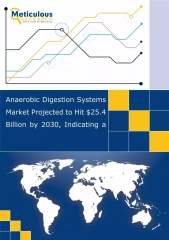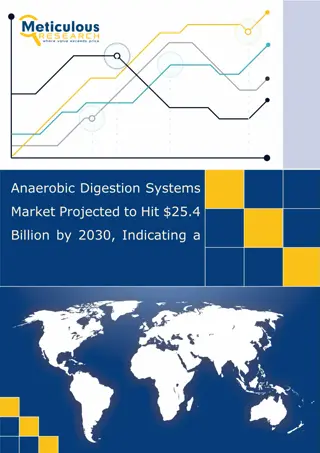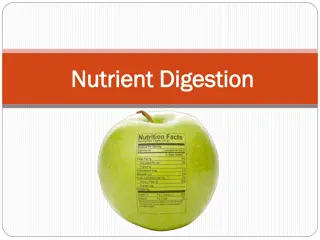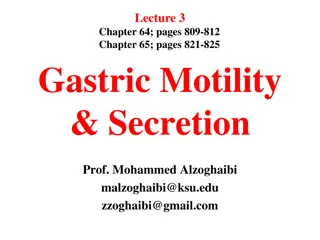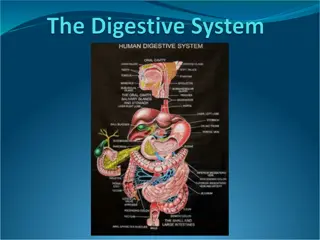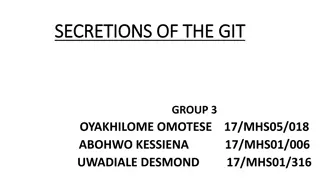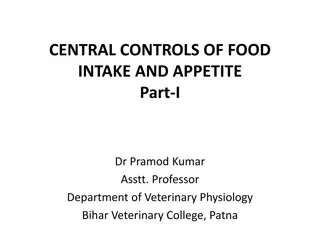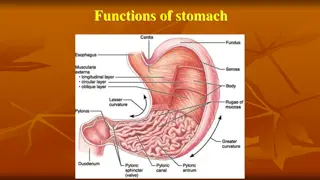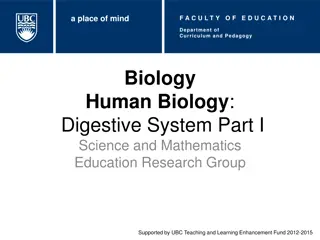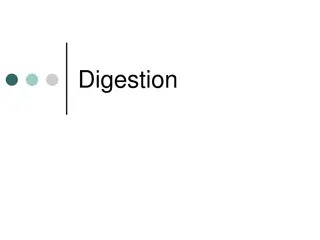Food Digestion Process
Food is essential for sustaining life, providing nutrients for growth and energy. The digestion process involves converting food into usable nutrients through the alimentary canal and various organs. It starts from the mouth, where food is chewed and begins its journey through the pharynx, esophagus, and stomach for further breakdown and absorption. Proper digestion is crucial for optimal nutrition and overall well-being.
Download Presentation

Please find below an Image/Link to download the presentation.
The content on the website is provided AS IS for your information and personal use only. It may not be sold, licensed, or shared on other websites without obtaining consent from the author.If you encounter any issues during the download, it is possible that the publisher has removed the file from their server.
You are allowed to download the files provided on this website for personal or commercial use, subject to the condition that they are used lawfully. All files are the property of their respective owners.
The content on the website is provided AS IS for your information and personal use only. It may not be sold, licensed, or shared on other websites without obtaining consent from the author.
E N D
Presentation Transcript
Food Food, substance consisting essentially of protein, carbohydrate, fat, and other nutrients used in the body of an organism to sustain growth and vital processes and to furnish energy. The absorption and utilization of food by the body is fundamental to nutrition and is facilitated by digestion.
Components of food 1. Carbohydrates 2. Protein 3. Fat 4. Vitamines 5. Minerals and salts
Digestion Digestion is the complex process of turning the food you eat into nutrients, which the body uses for energy, growth and cell repair needed to survive. The digestion process also involves creating waste to be eliminated.
Process The digestion process involves the alimentary canal along with various accessory organs and organ systems. It start from uptake of food, absorption and elimination digestion, up to
In humans, the process is quite simple due to our monogastric nature. This means that we have a one-chambered stomach, unlike other animals such as cows, which have four chambers.
1. Mouth Food starts its journey from the mouth or the oral cavity. There are many other organs that contribute to the digestion process, including teeth, salivary glands, and tongue. 1. Teeth are designed for grinding food particles into small pieces. 2. Salivary glands are moistened with saliva 3. Tongue taste and pushes the food into the pharynx.
Pharynx- A fibromuscular y-shaped tube attached to the terminal end of the mouth. 1. It is mainly involved in the passage of chewed/crushed food from the mouth through the oesophagus. 2. It also has a major part in the respiratory system, as air travels through the pharynx from the nasal cavity on its way to the lungs.
Oesophagus- This is a muscular tube that connects the pharynx, which is a part of an upper section of the gastrointestinal tract. It supplies swallowed food along with its length.
Stomach It serves as a muscular bag which is situated towards the left side of the abdominal cavity, beneath the diaphragm. This vital organ acts as a storage for the food and provides enough time to digest meals. The stomach also produces digestive enzymes and hydrochloric acid that maintains the process of digestion.
a. Mucous: It is an aqueous secretion produced by the mucous membranes. It functions by protecting the stomach lining and gastric pits from the acid, which is produced by the glands to destroy the bacteria that entered along with the food particles b. Digestive enzymes: They are the group of enzymes which functions by breaking down polymeric macromolecules like biopolymers into their smaller and simpler substances. c. Hydrochloric acid: It is the digestive fluid formed by the stomach during the process of digestion. It functions by destroying harmful microorganisms present in the food particles.
Small Intestine- The small intestine is a thin, long tube of about 10 feet long and a part of the lower gastrointestinal tract. It is present just behind the stomach a maximum area of the abdominal cavity. The complete small intestine is coiled and the inner surface consists of folds and ridges and acquires
1.Duodenum- It is 25 cm long and widest part of small intestine. Ampula of water open it , ampula connect with bile duct and pancreatic jduct . Iron is absorved in suodenum 2.Jejunum- Middle part of small intestine . 4 cm broad and 2.5 meter in length 3.Ileum- Its diameter 3.5 meter and 3.5 meter in length Finger like projections microvilli are found in the jejunum and ileum which increased the area of absorption of nutrients.
Large Intestine This is a thick, long tube measuring around 5 feet in length. It is present just beneath the stomach and wraps over the superior and lateral edges of the small intestine. It absorbs water and consists of bacteria (symbiotic) that support the breakdown of wastes to fetch small nutrients.
Rectum Waste products are passed into the end of the large intestine called the rectum and eliminated out of the body as a solid matter called stool. It is stored in the rectum as semi-solid faeces which later exits from the body through the anal canal through the process of defecation.
Accessory Organs of digestive system a. Pancreas- It is a large gland present just behind the stomach. It is short with its anterior connected to the duodenum and posterior pointing towards the left part of the abdominal cavity. The pancreas releases digestive enzymes to complete the process of chemical digestion. b. Liver- The liver is a roughly triangular, reddish-brown accessory organ of the digestive system located to the right of the stomach. It produces bile, which helps in the digestion of fat in the small intestine. The bile is stored and recycled in the gallbladder. It is a small, pear-shaped organ which is located just next to the liver.
3. Gallbladder is a small, pear-shaped organ on the right side of your abdomen, just beneath your liver. The gallbladder holds a digestive fluid called bile that's released into your small intestine.
The digestion process takes place in the following steps. A. Ingestion- The very first step involves mastication (chewing). The salivary glands, along with the tongue, helps to moisten and lubricate food, before being pushed down into the food pipe. B. Mixing and Movement- It involves the process of lubricating and manipulating food and pushing it down the food through the food pipe (using peristalsis), and into the stomach. C. Secretion- The stomach, small intestine, liver, and pancreas secrete enzymes and acids to aid the process of digestion. It functions by breaking down food particles into simple components and easily absorbable components.
D. Digestion- The process of converting complex food particles into simpler substances in the presence of enzymes and acids secreted by different digestive organs. E. Absorption- This process begins in the small intestine where most of the nutrients and minerals are absorbed. The excess water in the indigestible matter is absorbed by the large intestines. F. Excretion- The process of removing indigestible substances and waste by-products from the body through the process of defecation.
Digestion of Carbohydrate Digestion in mouth cavity Digestion in small intestine
Digestion of proteins in Stomach) Proteins are made up of amino acids so proteins are break down in amino acids (
Digestion of Nucleic Acid Nucleic acid are digested in the small intestine Nucleic acid first digested by pancreatic juice and further intestinal juice
Absorption Absorption is a process by which nutrients pass from the alimentary canal into blood and lymph. Nutrients like arbohydrates, amino acidsfatty acids, vitamines, and water are absorbed
Site of absorption 90% of nutrients are absorbed in small intestine by micovilli. While 10% are absorbed in stomach and large intestine
Absorption of monosacchrides Glucose , fructose and galactose are absorbed in stomach and jejunum by the microvilli of stomach
Absorption of amino acids Amino acids are absorbed by active transport system in duodenum and jejunum. 95% to 98% of amino acides are absorbed in small intestine
Absorption of fatty acids Fat is insoluble in water so it can not reach in the blood stream directly. It react with bile and forms the water soluble droplets are called micelle. These micelle again break in very small droplets are called chylomicrons. Chylomicrons directly absorbed by lymphs and dropped in blood
Absorption of Nucleic acids (DNA and RNA) Nucleic acids (DNA and RNA) in foods are digested in the small intestine with the help of both pancreatic enzymes and enzymes produced by the small intestine itself.



